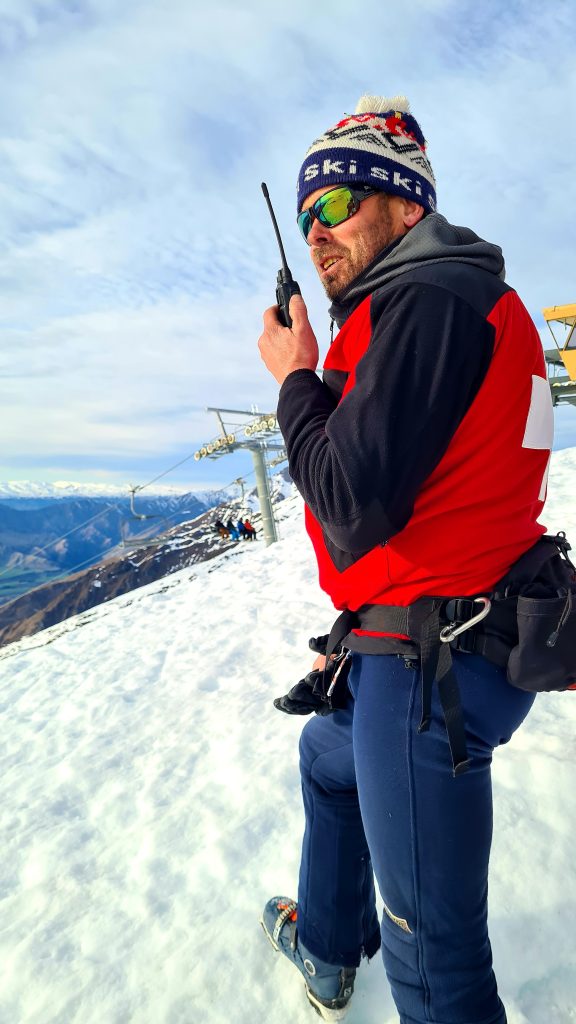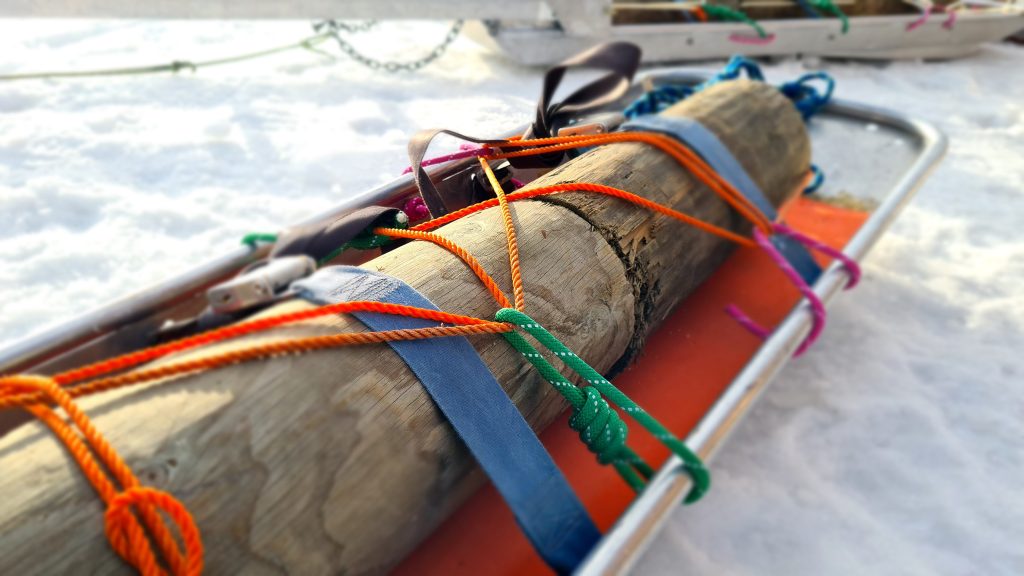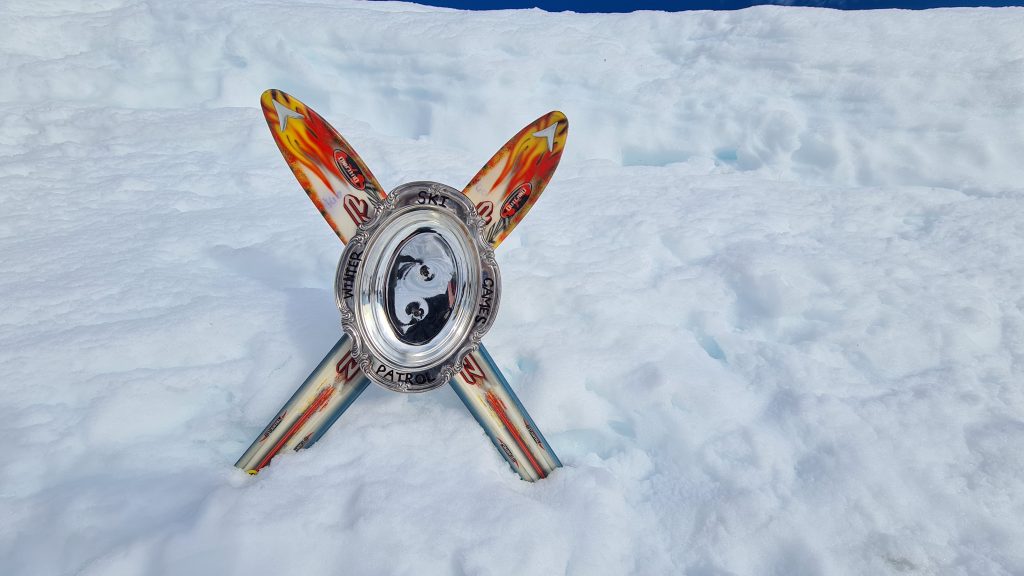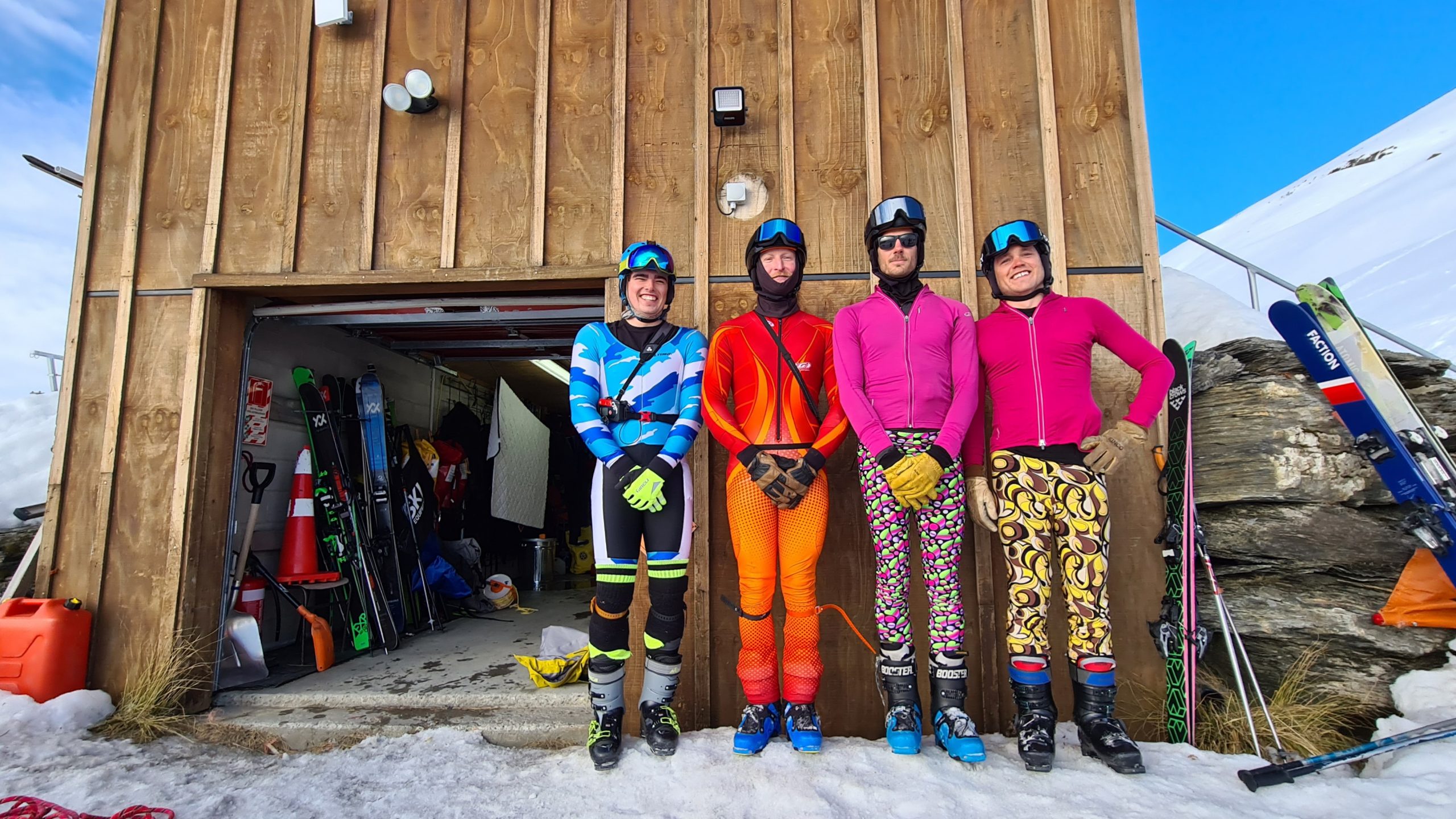On the slopes at the inaugural Ski Patrol Games.
Two guys are skiing down a racecourse towing a log in a stretcher. One is out in front, steering, while the other follows, tethered to the rig by a rope. They are dressed in suits and ties. Snow conditions are marginal. The log is visibly heavy. A crowd of onlookers looks on, concerned.

It’s August 2022, and the pair are competing in the inaugural Ski Patrol Games at Treble Cone. Patrol teams from four Southern Lakes ski fields – Cardrona, Treble Cone, Coronet Peak and The Remarkables – are taking part. The event is the brainchild of Callum Grant, who, having worked at Treble Cone as a patroller for the past 18 winters, is a familiar face around the place. He decided to run the games for a couple of reasons. One was to showcase, and put to the test, the broad skillset required for mountain patrol work. The other was to blow off some steam. “I wanted to put ski patrollers through some of the stuff we do every day and see who was the best. But also have some light-hearted fun in what can be a stressful environment,” he explains. With this in mind, he made it a fancy dress event. Hence the suits.
Ski patrolling is a multi-faceted job. Patrollers need to be strong skiers or snowboarders, able to get to, and extract, injured parties from anywhere on the mountain in a range of snow and weather conditions. Their work involves everything from outdoor first aid to avalanche forecasting and control, to deploying explosives, to handling a toboggan (the sled-style stretcher used to transport patients, which is what the boys above were manoeuvring through the race gates). A good dose of empathy helps, too, as does a sense of humour. Patrollers deal with a lot of frightened and traumatised people. Things can get serious, deadly even, and banter between co-workers can be a big part of coping. For Callum, the games needed to reflect that, too. “I wanted it so people could just come along and have at it, give each other a bit of shit,” he says.

Ski patrol contests have a long history overseas. The Canadian Ski Patrol Mountain Division’s first aid and toboggan skills competition has been contested for more than 50 years, having kicked off in 1969 at Sunshine Village near Calgary. As Jeremy McClaine, of the Mountain Division, tells it, “The Comp” featured “three-person teams in judged first aid scenarios, and a series of, er, controlled toboggan descents with a stopwatch.”
Over the years, the competitions have evolved to cover a wider range of skills. The U.S. Professional Ski Patrol Olympics, first held at Palisades Tahoe in 2010, includes beacon searches, simulated bomb deployments and a Giant Slalom. A Colorado Pro Ski Patrol event at Arapahoe Basin included a bamboo toss (the patrollers threw bamboo poles off from the steep Palivachen Lift at targets on the snow) and a Tough Mudder-style course complete with tyres and rope walls ̶ negotiated in ski boots, of course. And competitors at Big White in British Columbia in 2013 had to deal with a simulated stabbing in the base area.
It’s a snow-based, and less serious, take on the tradition of using competition to hone workplace skills and build comradery, especially in the lifesaving and rescue industries. Firefighting was an unofficial sport at the Paris Olympics in 1900. Teams had to put out a blaze in a six-storey house, and save a number of victims from the upper floors without using the stairs, which were, presumably, on fire. And surf lifesaving, well, isn’t that a thing. World Life Saving held the first world champs for beach- and ocean-based lifesaving activities in 1974 in South Africa. These days, the Worlds last for two weeks and attract up to 5000 competitors and officials. The idea, according to one governing body, is to “encourage lifesavers to develop, maintain and improve the essential physical and mental skills needed to save lives.”

Noble goals, but for Callum, inspiration came initially in the form the classic 1987 Kiwi ski film The Leading Edge, which he adored as a kid. It featured a ski race that involved haybales, netting and plywood structures, and the athletes having to “scull a Steinie” at the finish line.
Callum was attracted to the idea of “getting away from the world of health and safety, the reflective vests, cones, 18 different signs to tell you about a sign.” He was chuffed to have the ski field get in behind him, within reason. Beer chugging was definitely off the cards, as was the movie’s “wall of death” obstacle; the patrollers were going to have to stay functional for work the next day, after all. Nonetheless, “it’s a good thing for us, working in an environment where safety is our job, to be able to cut loose and have a fun event with a bunch of stunts.”
Treble Cone’s Ski Patrol Games was contested by teams of two. They completed a targeted “bomb toss” (the bombs being water-filled milk bottles); negotiated a thicket of race poles set out in clusters of varying density (as one skier put it, “if you weren’t’ getting a smack in the nuts, you were getting a smack in the face”); and an oral test consisting of five medical questions. These included “name five points of major haemorrhage in the body” and “where is your liver and spleen?”. According to Callum, “the only person who got them all right away just Googled.” OK, then. The patrollers also took a toboggan loaded with two tanalised posts down an alarmingly icy racecourse and though a mogul field, did a transceiver search, and navigated a “horrendous” maze at the bottom of the chairlift.
As Callum explained at the pre-race briefing, “we’ll have to make this up because we’ve never done it before”. Nonetheless, there was an official timer, and time penalties and bonuses were carefully calculated. Teams were penalised for infractions like not taking enough bombs (“one each, it’s not that hard”) and failing to complete a buddy check before leaving the start area. Almost everyone made it through unscathed, bar one poor fellow from The Remarkables who ripped a binding off and dislocated a shoulder during a tail roping mishap.

Treble Cone was the winner on the day, both as host and as the literal winner. “The weather was mint and the snow was good for an event like that. A lot of the time we have to rescue people and the skiing is crap,” Callum says, referencing the variable conditions off-piste. The victorious TC crew took home an op shop-sourced silver serving tray welded to the front half of a pair of Dynastar Outland 4x4s, the 1998 model with the flames on the tips. Second place was awarded the back half of the skis, while everyone else got an ‘L’ learner plate to display, proudly, in their patrol rooms.
WORDS & IMAGES: LAURA WILLIAMSON

